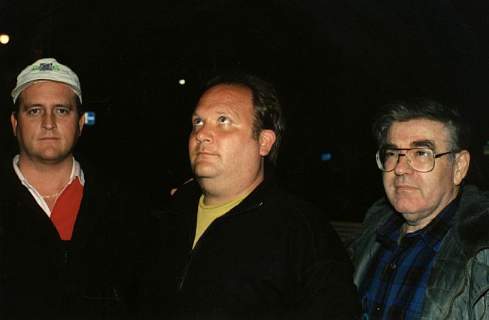
Manta Ray Performs for Skywatch Group
by Bruce Cornet, Ph.D.
Table of Contents
The Skywatch Group
On only two known occasions did the Manta Ray put on performances for people who gathered at the north end of West Searsville Rd
. One of the performances took place on the night of 14 October 1994 (Friday), and is the subject of this web page. The other took place ten days later on 24 October 1994 (Monday). The picture below was taken on 24 October; it shows (from left to right) Jim Lyons, Cliff Larson, and George Filer (New Jersey State Director of MUFON). They witnessed the Manta Ray take off from a nearby field, fly in a large omega-shaped path above fields separating forests, and then spiral down into one of the forests (presumably into an opening in the forest) where its lights could be seen passing behind trees. The white orbs in the picture are of unknown origin. They are not street lamps. Cliff is watching one of them dance above his head.
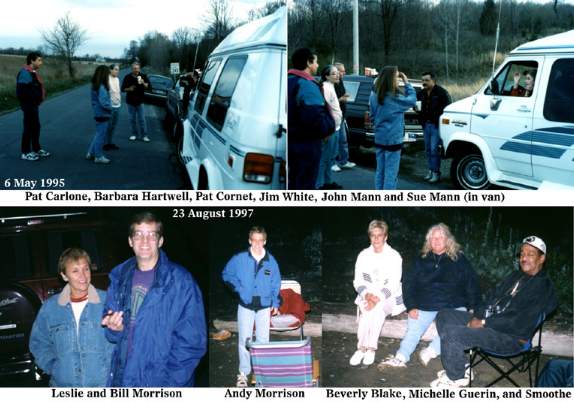
|
Throughout this period, until a new town ordinance ended sky watching on West Searsville Rd. in late 1997, you could find the same core group of watchers showing up again and again. People from Pennsylvania, New Jersey, Connecticut, New York City, upper New York State, Long Island, and New Hampshire traveled hundreds of miles to join those who gathered on that country road. Dr. Crystall came from Hawley, PA. Andy Morrison and his family came from Allentown, PA. Michelle Guerin came from Long Island. Barbara Hartwell, when she began her Pine Bush investigation, traveled from Guilford, CT. Later she moved to the area so that she could continue her research. Jim Durfee and Pat Carlone also came from Connecticut. Marc Whitford, Dinah Bertran, and Sharon Cunningham came from Maryland. Greg St. Pierre came from New Hampshire. Jim White's black truck with camper top and the Mann's white van were common features parked at that location on any good night for watching. Whenever I went to see who was there, I would usually end up becoming engaged in conversation and story swapping rather than watching for something unusual in the night sky. This was not the place to go if you were serious about photographing an AOP.
The Friday night performance was with the usual group of skywatchers that gathered along West Searsville Rd. What Cornet found most interesting was their reactions to this performance, and how easy it is for people to be fooled into adopting a conventional explanation. It may also be a very important reason why the Pine Bush phenomenon hasn't received more serious attention from investigators (other than Cornet and Crystall). But before I discuss their reactions, let me give a description of the event: The EventOn 14 October (Friday) Someone spotted a low pair of lights to the north behind the trees that surround a house at the north end of West Searsville Rd. From his knowledge of local maps and the terrain, Cornet realized that the lights were rising from a swampy area (now let's hear all the skeptics say, "How do you spell swamp gas?").
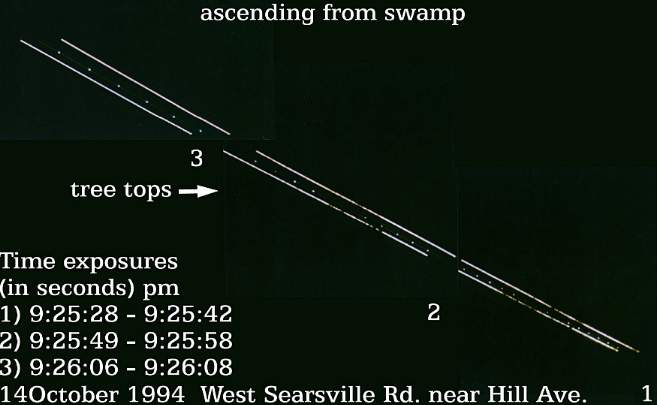
As they began to rise and come towards us, Cornet alerted other sky watchers in the group, and story telling momentarily ceased as all eyes focused on that pair of golden-white lights the size and brightness of car headlights. Close to a dozen people moved into the middle of the road to get an unobstructed view of the lights. "Its an aircraft flying south before turning towards Stewart (airport)," someone posited. But when the lights barely cleared the tree tops at the end of the road - silently, Cornet knew it was no conventional aircraft, in part because it was not obeying FAA flight regulations. Its extremely low altitude placed it below IFR operations and below radar detection.
FAA regulation 91.177 Minimum altitude for IFR operations. (a) Operation of aircraft at minimum altitudes. Except when necessary for takeoff and landing, no person may operate an aircraft under IFR below - (1) The applicable minimum altitudes prescribed in Parts 95 and 97 of this chapter; or (2) If no applicable minimum altitude is prescribed in those parts -- (i) In the case of operations over an area designated a mountainous area in part 95, an altitude of 2,000 feet above the highest obstacle within a horizontal distance of 4 nautical miles from the course to be flown; or (ii) In any other case, an altitude of 1,000 feet above the highest obstacle within a horizontal distance of 4 nautical miles from the course to be flown (AIM/FAR 1994 airman's information manual / federal aviation regulations). FAA regulation 91.303 Aerobatic flight. No person may operate an aircraft in aerobatic flight -- (a) Over any congested area of a city, town, or settlement; (b) Over an open air assembly of persons. For the purposes of this section, aerobatic flight means an intentional maneuver involving an abrupt change in an aircraft's altitude, an abnormal altitude, or abnormal acceleration, not necessary for normal flight.
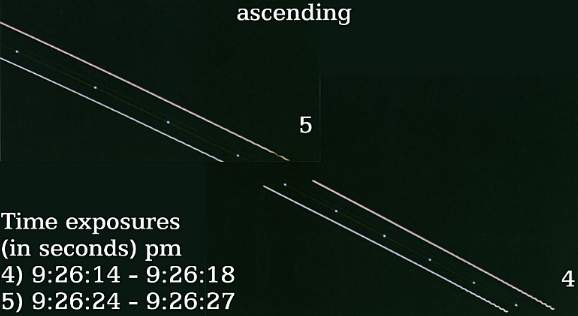
Quickly those with binoculars began focusing in on the object as it slowly flew just to our west. Cornet took ten time exposures of it with his Minolta SLR, which was mounted securely on a stable tripod. The craft disappeared behind a low north-south oriented ridge or hill to the west.
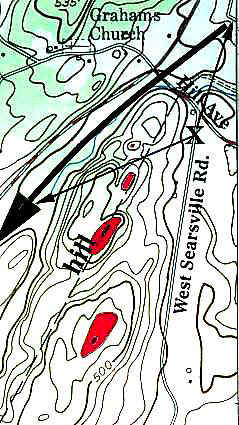
A simple trigonometric calculation based on distances and the highest point on that ridge indicates that this craft dropped below 300 feet in order to disappear behind the hill.
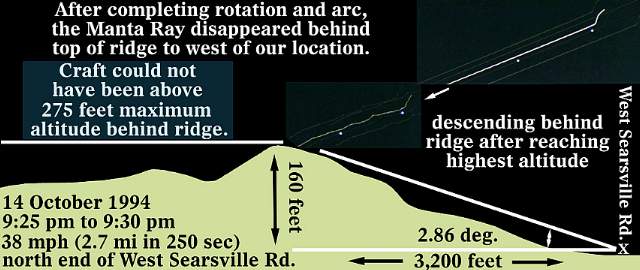
But what is even more unusual is that his time exposures show that the craft slowly rotated as if banking, but maintained a straight path in a nearly vertical orientation as it passed us to the west. Photograph #7 (below) even shows a movement of its lights which resembles a sine wave pattern, implying that the propulsion system had been given a boost in order to maintain stable flight. That pattern is not due to camera vibration (the camera was mounted on a stable tripod), which is of a different shape and, if it occurs, only occurs just after the shutter is opened. The sine wave pattern, however, is in the middle of the time exposure.
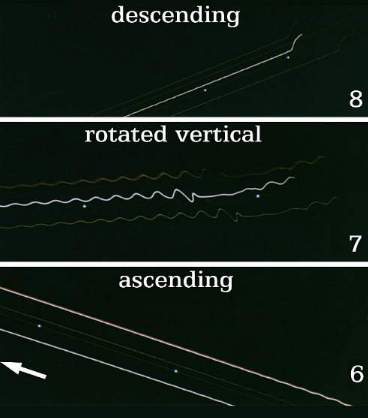
In a vertical orientation the craft's angular left side could be mistaken for a tail fin. It rose to its highest altitude almost due west of our location, and then began a slow descent behind the hill, forming a gentle arcing flight path. After disappearing for about three minutes behind the ridge, it re-emerged to the south as it came through a gap in the ridge where South Searsville Rd. climbs over the ridge. The craft had rotated back to a horizontal orientation. The last time exposure (below: #10) was taken at 9:30:00 - 9:30:10 pm as the AOP flew east over South Searsville Rd. It continued to descend until it disappeared behind tree tops to the southeast, at least eight miles short of the Stewart airport runway! At no point during the event did the AOP reach minimum FAA-required altitude of 1,000 feet. It traveled 2.7 miles in 250 seconds, which computes to an average speed of 38 mph! This performance of the Manta Ray is reminiscent of the 29 April 1993 performance, the subject of Volume IV called The Performance.
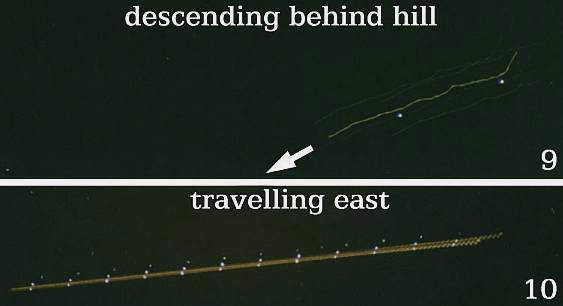
The reaction of the core group of sky watchers was both interesting and disappointing. Because most of them did not routinely take photographs of suspected anomalous lights, and because most of them were engaged more in social activities, Cornet got one of his best experiences that night watching them analyze something that to him was highly anomalous. Most of the times when Cornet had stopped by to learn of any new and unusual sightings, he heard the all too familiar response, "We haven't seen anything but airplanes." Because Cornet had come out many nights during 1992 through 1993, and because he had taken the time, effort, and expense to record almost everything he saw flying at night, he had accumulated an enormous amount of photographic evidence for anomalous craft. Thus, Cornet wondered how this core group of people, coming out at night even more frequently than he had over the years, wasn't seeing anything. As the Manta Ray passed behind the low hill to our west Jim White blurted out that he saw a tail fin through his binoculars, and concluded that it was just a conventional aircraft as had been posited earlier when the lights were too far away to determine what it was. Someone else in the group also said he thought he saw a tail fin through his binoculars, but another person wasn't so convinced. She noted that the object was too low to the ground and flying too slowly to be a conventional jetliner, but Jim insisted that it was a plane. With that everyone returned to their former activities along the side of the road, and one of the best performances of the Manta Ray Cornet has on film was summarily dismissed as "nothing extraordinary."

Cornet rattled off a list of reasons for suspecting that it was the Manta Ray, but none of the people there were persuaded to change their minds. Apparently the angular left side of the craft sticking up in the air had been mistaken for a tail fin, even though a clear outline of a conventional airframe with wings was not visible. Hill (1995) gives an explanation for why AOP using plasma lights can have indistinct outlines. Apparently, it was more believable to think that they had seen a large conventional aircraft flying well below normal altitude (even for a plane on approach to an airport nine miles away) than an unconventional aircraft with an unfamiliar shape doing illegal aerobatics for our entertainment. Without videotape or photographs to analyze on the spot, Cornet wondered just how much they had missed. On that night Cornet became convinced that the core group of skywatchers wanted something that was extraordinary and which didn't require much analysis or thought to conclude that it was an AOP.
Because this sighting required the analysis of photographs, and calculations of distance, speed, and altitude in order to rule out a conventional jetliner, it should become apparent to the reader that on location identification at night is very difficult to impossible using unaided eyes and binoculars, especially if the object in question is camouflaged in any way. Most of Cornet's sightings required detailed data analysis before he was certain that the AOP was not a conventional aircraft. High tech instruments, such as a spectroradiometer and optical tracking and triangulating devices, are required in the field in order to identify unique aspects of AOP shape, lighting, speed, and distance. Unfortunately, such instruments are very expensive, precluding their use by non-professionals.
NEXT PAGE (2 of 2)
Copyright © 1999 Sirius Onion Works
Last modified:
June 05, 2024